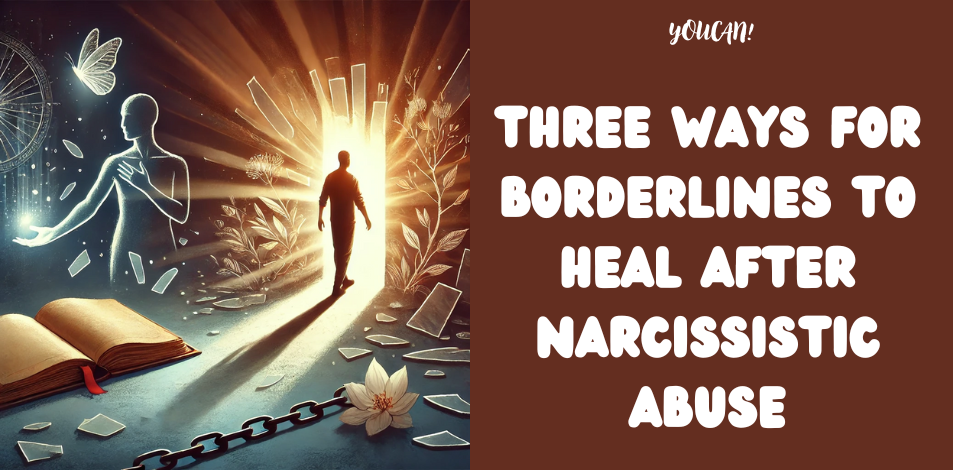
Surviving a relationship with a narcissist can be incredibly difficult for anyone, but for individuals with borderline personality disorder (BPD), the emotional aftermath can feel overwhelming. People with BPD are often emotionally sensitive and deeply affected by abandonment and rejection, which makes them more vulnerable to the manipulative tactics of narcissists. Healing after narcissistic abuse is possible, though it requires patience, self-compassion, and specific strategies tailored to the emotional struggles that those with BPD face. Here are three essential ways for borderlines to heal after narcissistic abuse.
1. Establish Strong Boundaries
One of the most crucial steps in healing from narcissistic abuse is learning how to set and maintain strong boundaries. Individuals with BPD may struggle with boundaries due to a fear of rejection or a deep need for validation from others. Narcissists, who often thrive on controlling their partners, can erode personal boundaries over time, leaving a person feeling powerless and confused.
To heal, it’s essential to:
Recognize your needs: Understand what behaviors are acceptable and unacceptable for your emotional well-being.
Related : Why Do Narcissists Listen to Sappy Love Songs?
Reclaim your autonomy: Focus on regaining control over your decisions, feelings, and space. Remind yourself that you have the right to say no and to protect yourself from harm.
Limit contact with the narcissist: Whether it’s going no-contact or establishing strict emotional boundaries, limiting exposure to the narcissist is key to preventing further manipulation and promoting healing.
By strengthening boundaries, you create a safer space for emotional recovery, preventing the narcissist from continuing their control over your life.
2. Engage in Trauma-Focused Therapy
Therapy is a crucial part of healing, especially for those with BPD who are recovering from the emotional trauma of narcissistic abuse. A specialized therapist can help address the emotional turmoil that stems from the abuse, as well as the inherent challenges of BPD, such as intense emotional reactions and a fear of abandonment.
Two effective therapeutic approaches for healing are:
Dialectical Behavior Therapy (DBT): DBT is often recommended for individuals with BPD, as it teaches skills for managing intense emotions, improving relationships, and coping with distress. It focuses on mindfulness, emotional regulation, and building healthy interpersonal skills.
Trauma-Focused Cognitive Behavioral Therapy (TF-CBT): This approach helps process the trauma experienced during the abusive relationship. It works by identifying and challenging distorted thoughts related to the abuse, reframing them, and developing healthier coping strategies.
Therapy provides the tools to rebuild self-esteem, process emotional pain, and ultimately heal from both the trauma of the narcissistic relationship and the underlying struggles of BPD.
3. Rebuild Your Sense of Self-Worth
After experiencing narcissistic abuse, many individuals with BPD are left feeling worthless or inadequate. Narcissists often belittle, criticize, and manipulate their victims, leaving them to doubt their own worth and value. For someone with BPD, whose self-image may already be fragile, this can be particularly devastating.
Rebuilding your sense of self-worth is an essential part of healing. Here are some ways to do that:
Practice self-compassion: Acknowledge the pain you’ve been through, and allow yourself the space to heal without judgment. Be kind to yourself during this process, recognizing that your worth is intrinsic, not dependent on someone else’s approval.
Related : 17 Things to Know if You’re in Love with a Sociopath or Psychopath
Engage in activities that reinforce your strengths: Remind yourself of your positive qualities and skills. Engaging in hobbies, creative pursuits, or physical activities that bring you joy and confidence can help reinforce a healthier self-image.
Surround yourself with supportive people: Reconnect with friends, family, or support groups who provide validation, empathy, and understanding. Building positive relationships with people who care about your well-being can be a powerful antidote to the emotional isolation caused by the narcissist.
By focusing on self-compassion, reconnecting with your strengths, and seeking supportive relationships, you can gradually rebuild your self-esteem and sense of worth.
Conclusion
Healing from narcissistic abuse can be an incredibly challenging journey, especially for individuals with borderline personality disorder. However, by establishing firm boundaries, engaging in trauma-focused therapy, and rebuilding self-worth, it’s possible to recover from the emotional damage inflicted by a narcissistic relationship. With time and the right tools, you can heal and regain control of your life, emerging stronger and more resilient than before.




